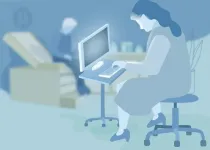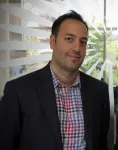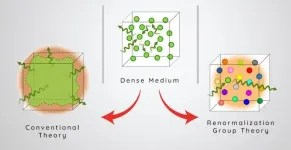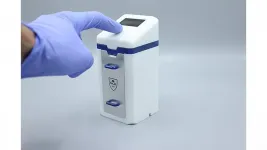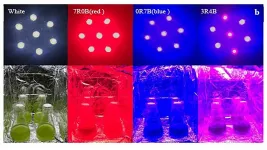(Press-News.org) Judges don't do court stenography. CEOs don't take minutes at meetings. So why do we expect doctors and other health care providers to spend hours recording notes -- something experts know contributes to burnout?
"Having them do so much clerical work doesn't make sense," said Lisa Merlo, Ph.D., an associate professor of psychiatry and director of wellness programs at the University of Florida College of Medicine. "In order to improve the health care experience for everyone, we need to help them focus more on the actual practice of medicine."
Physician burnout affects patients, too. Stressed doctors are less compassionate and more likely to make mistakes. Clinicians who leave the field or cut back hours reduce patient access to care, and replacing doctors in the midst of a physician shortage drives up costs.
"We can't ignore burnout and expect doctors to just keep picking up the slack," Merlo said.
Electronic health records -- or EHRs -- have enabled better, faster and more accurate communication among health care providers. But the time required to populate them can mean less interaction with patients and more time after hours typing notes, which can be more driven by insurance requirements than usefulness in patient care.
To find solutions, Merlo teamed up with Oliver Nguyen, a research coordinator and IT specialist in the College of Medicine, to evaluate 35 studies of records-related burnout, looking for common threads. Their study, published in the Journal of the American Medical Informatics Association, is part of a special issue on physician burnout.
"The longer clinicians spend on records, especially after hours or on weekends, the more it's associated with burnout," Nguyen said.
As the pandemic stretches health care workers ever thinner, "we're beyond the straw that broke the camel's back," Merlo said. "The system has survived for so long because physicians step up and get the work done out of a sense of altruism and dedication to their patients. But there's only so long you can sustain that."
Physician wellness initiatives have increased during the pandemic, often focusing exclusively on self care. But "adding more yoga classes is not going to address a clinician working on electronic health records at home at 11 p.m.," Merlo said.
Streamlining record-keeping could help. So when Nguyen approached Merlo about optimizing electronic records, she was eager to collaborate. With colleagues at the University of Alabama at Birmingham, the U.S. Navy, Moffitt Cancer Center, the University of South Florida and the University of Central Florida, they uncovered several potential solutions that could help physicians. (Another study looked at nurse burnout; future research will include other health care providers.)
Their recommendations:
Share the load
Overflowing inboxes contribute to burnout. As the pandemic shifts some office visits to videoconference, email and phone communication, "inboxes are blowing up," Nguyen said. A shared inbox that allows office staff to triage messages that don't require a doctor's input, such as insurance questions, can help.
Revisit policy
The Centers for Medicare and Medicaid Services launched the Patients over Paperwork initiative in part to reduce the documentation requirements. If it shows promising results for reducing records burden, Nguyen and Merlo say, it could serve as a model for private insurers to emulate.
Create power users
Even when they're familiar with an EHR interface, doctors might not know about time-saving features like templates and bookmarks. An optimization team that offers proactive support can streamline time spent in the system.
Collaborate on design
"Usability continues to be a struggle for physicians," Nguyen said. More input from users can help when it comes to designing EHRs, as well as selecting and implementing them.
"The good news is, a lot of the issues can be fixed," Merlo said. "If we invest in these resources, we can make this better for patients, for health care providers, for everybody."
INFORMATION:
Mount Sinai researchers have found that a widely available and inexpensive drug targeting inflammatory genes has reduced morbidity and mortality in mice infected with SARS-CoV-2, the virus that causes COVID-19. In a study published today in the journal Cell, the team reported that the drug, Topotecan (TPT), inhibited the expression of inflammatory genes in the lungs of mice as late as four days after infection, a finding with potential implications for treatment of humans.
"So far, in pre-clinical models of SARS-CoV-2, there are no therapies--either antiviral, antibody, or plasma--shown to reduce the SARS-CoV-2 disease burden when administered after more than one day post-infection" says senior author Ivan Marazzi, PhD, Associate Professor of Microbiology ...
Research into the diets of a large number of the world's carnivores has been made publicly available through a free, online database created by a PhD student at the University of Sussex.
From stoats in the UK to tigers in India, users are now able to search for detailed information about the diets of species in different geographical locations around the globe.
Created by doctoral student Owen Middleton, CarniDIET is an open-access database which aims to catalogue the diets of the world's carnivores by bringing together past peer-reviewed research. He hopes it will be a useful resource for conservationists and researchers, as well as educators and nature-lovers alike.
Owen said: "There is so much information out ...
A simple plastic water bottle isn't so simple when it comes to the traditional manufacturing process. To appear in its final form, it has to go through a multi-step journey of synthetic procedure, casting, and molding. But what if materials scientists could tap into the same biological mechanisms that create the ridges on our fingertips or the spots on a cheetah in order to manufacture something like a water bottle?
A research paper titled END ...
Preclinical research from VCU Massey Cancer Center published recently in the Proceedings of the National Academy of Sciences shows that the combination of two existing drugs can exploit the metabolic "hunger" of a particularly aggressive type of neuroblastoma to kill cancer cells without inflicting too much collateral damage to healthy tissue.
Neuroblastoma - a type of cancer that strikes the nervous system of very young children - is one of the deadliest pediatric cancers. And children whose neuroblastoma overexpresses the gene MYCN tend to have the worst prognosis.
While medical advancements have led to high cure ...
LOWELL, Mass. - Too often, contends UMass Lowell faculty researcher Brenna Morse, children with complex chronic medical conditions spend days in the hospital undergoing tests for what could be a simple diagnosis.
The challenges include, she says, some children with medical complexities, such as severe neurological conditions and functional impairments, cannot easily signal that they are in pain or point where in their body it is located. Where children not facing such a challenge might be able to have a medical issue resolved with a simple visit to their primary care doctor, others end up hospitalized and going through days of costly testing to arrive at similar diagnoses.
Morse, a UMass Lowell ...
Pink Floyd's Dark Side of the Moon cover, voted the greatest classical rock album of all time, intended to portray the prism and dispersion of light into a rainbow as a certain metaphorical symbolism and a light show that was never celebrated. However, they really were not aware of the fact that this image would be used by many to help illustrate the concept of refractive index and how light changes speed and direction when it encounters a different medium.
Although conceptually the drawing was not accurate, it conveyed the message that light changes its speed when it moves into another medium, and that the different speeds of different colors causes white light to disperse ...
Sausalito, Calif. (March 30, 2021) - After more than three decades of research, scientists have proven that the cancer affecting up to one in four adult California sea lions necrospied at The Marine Mammal Center in Sausalito, CA, is caused by a sexually transmitted herpesvirus. The cancer, known as sea lion urogenital carcinoma, has clear parallels to cervical cancer in humans and provides a helpful model for human cancer study.
Scientists have long suspected this cancer was associated with a virus, but this is the first study to prove this theory. The study, which was published in Animals, an open-access, peer-reviewed journal, concluded that genital herpesvirus is ...
WASHINGTON, March 30, 2021 -- Emerging technologies can screen for cervical cancer better than Pap smears and, if widely used, could save lives both in developing nations and parts of countries, like the United States, where access to health care may be limited.
In Biophysics Reviews, by AIP Publishing, scientists at Massachusetts General Hospital write advances in nanotechnology and computer learning are among the technologies helping develop HPV screening that take the guesswork out of the precancer tests. That could mean better screening in places that lack highly trained doctors and advanced laboratories.
Cervical cancer is the world's fourth-most common cancer, with more than ...
WASHINGTON, March 30, 2021 -- As ethanol, biodiesel, and other biofuels continue to present challenges, such as competing with food security or lacking the technology for more efficient and low-cost production, microalgae are gaining momentum as a biofuel energy crop.
In their paper, published in the Journal of Renewable and Sustainable Energy, by AIP Publishing, Yangzhou University researchers in China show how a combination of monochromatic red and blue LED illumination on one type of microalga can enhance its growth and increase the biosynthesis of critical components, such ...
New observations with the European Southern Observatory's Very Large Telescope (ESO's VLT) indicate that the rogue comet 2I/Borisov, which is only the second and most recently detected interstellar visitor to our Solar System, is one of the most pristine ever observed. Astronomers suspect that the comet most likely never passed close to a star, making it an undisturbed relic of the cloud of gas and dust it formed from.
2I/Borisov was discovered by amateur astronomer Gennady Borisov in August 2019 and was confirmed to have come from beyond the Solar System a few weeks ...
